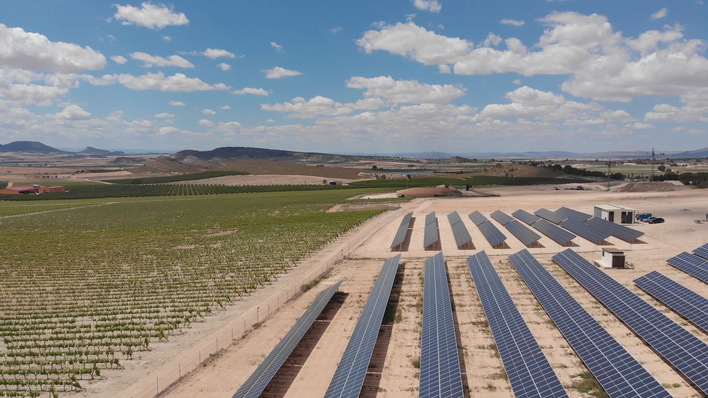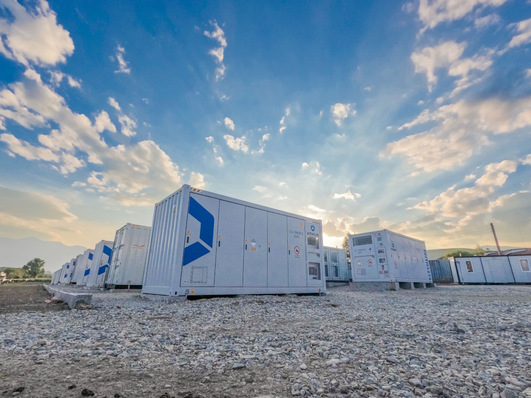Read Part 1 here: GILDEMEISTER delivers complete energy packages for the industry
Three storage systems are currently running in Bielefeld: a large CellCube FB 200-400 producing 200 kilowatts and with a storage capacity of 400 kilowatt hours as well as two of its smaller siblings – the CellCube FB 30-130.
It is their job to cut loads and harmonise them with the yield curves of the SunCarriers, the fixed ground-mounted and (two smaller) roof-top installations as well as three wind turbines. Also, they are offering free 100 percent renewable electricity for charging the EVs of employees and customers.
So far, the Bielefeld site is 20 percent self-reliant. In 2015, energy costs could be cut by 30 percent compared to 2012 – a model for the other factories of DMG MORI around the world. “Our other sites are currently also being analysed for their solar self-consumption potential,” Christian Kleinhans reports. “Based on this, the local managers are given their respective targets. We can actually calculate our energy costs in kilowatt hours per unit sold.”
Some storage units using redox flow technology
In the meantime, GILDEMEISTER energy solutions markets its solutions to industry. The redox flow storage units are being built in Vienna, while the solar systems are being designed in Wuerzburg in Bavaria. “We offer industry customers an all-in package solution for lowering energy costs long-term,” the manager explains. “Solar by itself is not a solution for industry. Generally, consumption at the various points needs to be measured, specifically lowered and then supplied by renewable generators. Energy, industry and digitalisation mesh very well.”
Until now, GILDEMEISTER energy solutions has installed about 250 megawatts of photovoltaics around the world. “I am witnessing a rising global demand for self-consumption solutions involving PV,” Kleinhans comments. “It might be 150 kilowatts here or half a megawatt there.”
Even in Russia in DMG MORI’s Ulyanovsk factory, solar generators producing a total of 250 kilowatts were installed. In Cairo, a solar park with about a megawatt is being set up.
In 2014, GILDEMEISTER energy solutions installed about 30 megawatts of PV, in 2015, it was even 40 megawatts. “The trend is clearly rising. You can see that from the projects that we are being offered. Large investment consortia are behind them.”
Restructuring the global economy
Slowly but surely, the restructuring of the global economy is gathering pace – because solar and wind power help to reduce costs; and because storage units such as the redox flow systems make bespoke solutions possible.
GILDEMEISTER energy solutions has fully committed itself to this technology, “because it allows us to create an application which it would be harder to achieve with lithium-based technologies,” as Christian Kleinhans explains. “The storage unit has to last as long as the solar array, i.e. 20 years.”
Power and capacity can be expanded easily
Furthermore, the redox flow storage unit just acts as capacity storage, and its capacity can be extended modularly according to the needs of industrial customers. “It can buffer surplus electricity from solar PV over long periods of time and runs independent of cycles,” Kleinhans explains. “The electrolytes in both reservoirs don’t deplete; and more reservoirs mean greater capacity.”
As needed, the electrolytes (among the key components are water, vanadium and sulphuric acid) are pumped from the reservoirs into the stacks of the storage unit where they create a voltage across the membranes.
It fits to (almost) all sizes
The CellCube FB 200-400 produces 200 kilowatts and has a capacity of 400 kilowatt hours. The CellCube FB 200-800 has a capacity of 800 kilowatt hours, i.e. can produce 200 kilowatts over 4 hours.
GILDEMEISTER energy solutions has so far set up 130 redox flow storage units in the field. They have been on sale since 2008. For instance, their products are being used by large car makers in Wolfsburg, Zwickau, Emden and Bratislava.
Food retailers use such storage raise their level of self-consumption. A very large storage unit (FB 200-1,600), operated by E.ON, has been installed on the island of Pellworm, supplying more than a thousand people in about 600 households.
If experts talk about small storage, what they mean is usually something like the FB 10/20/30 series – a unit that produces ten, 20 or 30 kilowatts. This is already sufficient for a company to last the night without having to draw power from the grid. In Bhopal in India, for example, three redox flow storage units operate as an off-grid island system in tandem with PV.
Operation and maintenance out of one hand
Such applications can also be interesting to telecommunications for powering transmitter towers. Transmitter towers are so far usually powered by diesel generators that generate their electricity. Their transmitter power output is five kilowatts.
Even without PV, a redox flow storage unit significantly lowers costs. If a 15-kilowatt diesel generator is combined with one or two ten-kilowatt storage units (for example with 100 kilowatt hours each), the storage works as a buffer. Once it is full, the generator can be switched off.
Hybrid systems with PV and diesel generation or wind turbines
This mode of operation alone means the generator is started and stopped less often and protects the engine. Add PV or small wind turbines and the generator is downgraded to being an emergency power system – just in case the sun does not shine or not enough wind blows.
GILDEMEISTER energy solutions offers such sophisticated technologies along with operations management and maintenance – both for off-grid applications and for industrial customers. This is the only way to ensure that once they are installed, the units actually produce the results and yields that were promised as the investment was made.
In 2014, GILDEMEISTER energy solutions was certified as a by TÜV Rheinland as specialists for the maintenance of PV installations. The certification criteria include the qualifications of the employees, the quality and scope of the services as well as the completeness and transparency of the documentation, including monitoring. (Heiko Schwarzburger)
Did you like “Saving money with large vanadium flow batteries”? So could be interesting for you, too: “Novel Israeli Iron Flow Battery Will Drive Down Costs For Energy Storage”.
And do not miss the upcoming event in UK on storage market opportunities, at November 1, 2016 in Milton Keynes!







